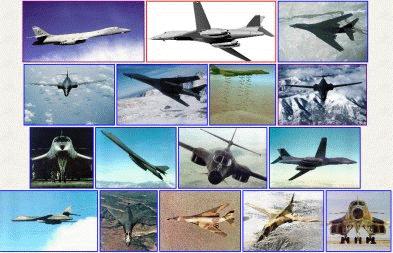





The B-1B is a multi-role, long-range bomber, capable of flying intercontinental missions without refueling, then penetrating present and predicted sophisticated enemy defenses. It can perform a variety of missions, including that of a conventional weapons carrier for theater operations. Through 1991, the B-1 was dedicated to the nuclear deterrence role as part of the single integrated operational plan (SIOP)
The B-1B's electronic jamming equipment, infrared countermeasures, radar location and warning systems complement its low-radar cross-section and form an integrated defense system for the aircraft.
The swing-wing design and turbofan engines not only provide greater range and high speed at low levels but they also enhance the bomber's survivability. Wing sweep at the full-forward position allows a short takeoff roll and a fast base-escape profile for airfields under attack. Once airborne, the wings are positioned for maximum cruise distance or high-speed penetration. The B-1B holds several world records for speed, payload and distance. The National Aeronautic Association recognized the B-1B for completing one of the 10 most memorable record flights for 1994.
The B-1B uses radar and inertial navigation equipment enabling aircrews to globally navigate, update mission profiles and target coordinates in-flight, and precision bomb without the need for ground based navigation aids. Included in the B-1B offensive avionics are modular electronics that allow maintenance personnel to precisely identify technical difficulties and replace avionics components in a fast, efficient manner on the ground.
The aircraft's AN/ALQ 161A defensive avionics is a comprehensive electronic counter-measures package that detects and counters enemy radar threats. It also has the capability to detect and counter missiles attacking from the rear. It defends the aircraft by applying the appropriate counter-measures, such as electronic jamming or dispensing expendable chaff and flares. Similar to the offensive avionics, the defensive suite has a re-programmable design that allows in-flight changes to be made to counter new or changing threats.
The B-1B represents a major upgrade in U.S. long-range capabilities over the B-52 -- the previous mainstay of the bomber fleet. Significant advantages include:
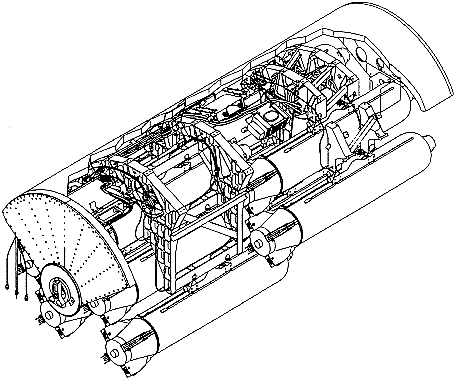 Numerous sustainment and upgrade modifications are ongoing or under study for the B-1B aircraft. A large portion of these modifications which are designed to increase the combat capability are known as the Conventional Mission Upgrade Program. In FY93, The Air Force initiated CMUP in FY1993 to improve the B-1’s conventional warfighting capabilities.
The $2.7 billion CMUP program is intended to convert the B-1B from a primarily nuclear weapons carrier to a conventional weapons carrier. Capability will be delivered in blocks attained by hardware modifications with corresponding software updates:
Numerous sustainment and upgrade modifications are ongoing or under study for the B-1B aircraft. A large portion of these modifications which are designed to increase the combat capability are known as the Conventional Mission Upgrade Program. In FY93, The Air Force initiated CMUP in FY1993 to improve the B-1’s conventional warfighting capabilities.
The $2.7 billion CMUP program is intended to convert the B-1B from a primarily nuclear weapons carrier to a conventional weapons carrier. Capability will be delivered in blocks attained by hardware modifications with corresponding software updates:
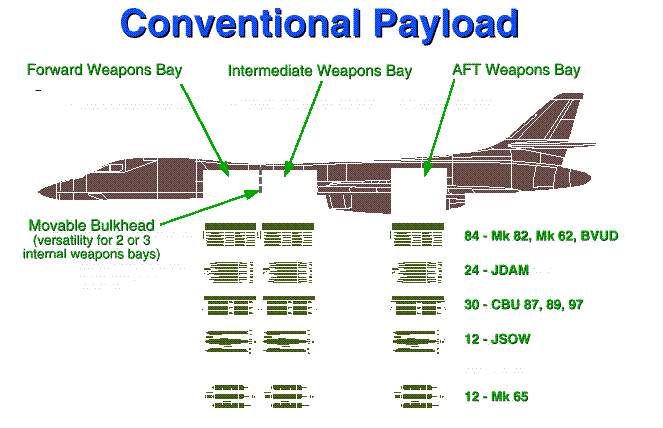
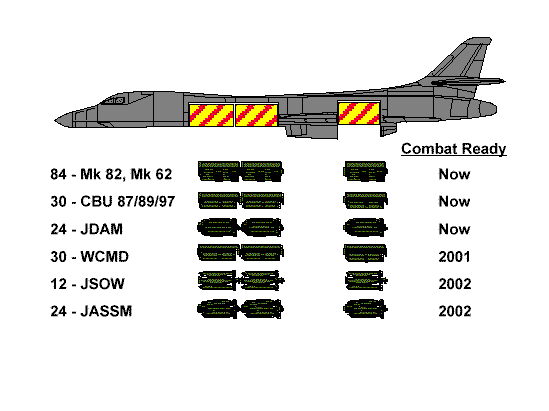
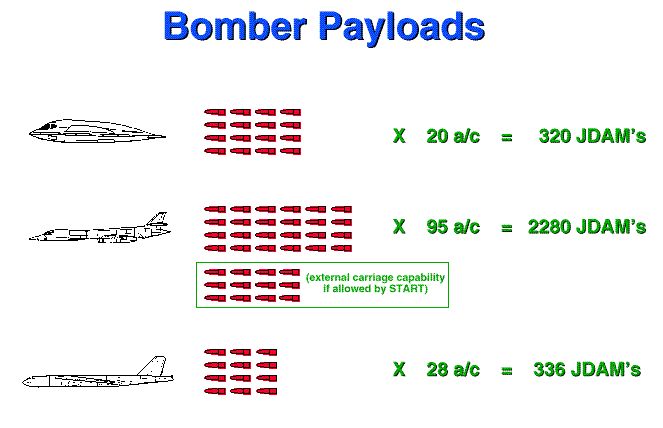
The B-1B is a modified B-1A with major revisions in offensive avionics, defensive avionics, weapon payload, range, and speed. These modifications were made to incorporate certain technological advances that had occurred between the original B-lA contract award in 1970 and the LRCA competition in 1980. Improvements consist primarily of off-the-shelf technology such as a new radar, new generation computers, expanded ECM capabilities, reduced RCS, and avionics compatibility with the ALCM. The wing sweep is restricted to 60 which limits the maximum speed to just above supersonic. Rockwell also estimated range increases for the modified B-1.
Differences between the B-1B and its predecessor, the B-1A of the 1970s, are subtle, yet significant. Externally, only a simplified engine inlet, modified over-wing fairing and relocated pilot tubes are noticeable. Other less-evident changes include a window for the offensive and defensive systems officers' station and engine housing modifications that reduces radar exposure. The B-1B was structurally redesigned to increase its gross takeoff weight from 395,000 to 477,000 pounds (177,750 to 214,650 kilograms). Still, the empty weight of the B-1B is but 3 percent greater than that of the B-1A. This added takeoff weight capacity, in addition to a movable bulkhead between the forward and intermediate weapons bay, allows the B-1B to carry a wide variety of nuclear and conventional munitions. The most significant changes, however, are in the avionics, with low-radar cross-section, automatic terrain-following high-speed penetration, and precise weapons delivery.Prior to 1994 B-1B fleet had never achieved its objective of having a 75-percent mission capable rate. In 1992 and 1993 the B-1B mission capable rate averaged about 57 percent. According to the Air Force, a primary reason for the low mission capable rate was the level of funding provided to support the B-1B logistics support system. Concerned about the low mission capable rate, a history of B-1B problems, and the Air Force's plans to spend $2.4 billion modifying the B-1B to become a conventional bomber, the Congress directed the Air Force to conduct an Operational Readiness Assessment (ORA) from June 1, 1994, through November 30, 1994. The purpose of the ORA was to determine whether one B-1B wing was capable of achieving and maintaining its planned 75-percent operational readiness rate for a period of 6 months, if provided the full complement of spare parts, maintenance equipment and manpower, and logistic support equipment. During the ORA the test unit achieved an 84.3-percent mission capable rate during the test period. The ORA demonstrated that, given a full complement of spare parts, equipment, and manpower, the Air Force could achieve and sustain a 75-percent mission capable rate for the B-1B. The Air Force projects that the entire B-1B fleet will reach a 75-percent mission capable rate by 2000 by virtue of numerous on-going and future reliability, maintainability, and management initiatives. However, as of mid-October 1999 the Air Force wide mission capable rate of the B-1 had fallen to 51.1 percent -- mainly because of maintenance problems and a shortage of parts. Over the previous 12 months, the Kansas Guard had maintained a mission capable rate of 71.1 percent for the 10 usable aircraft assigned to it.
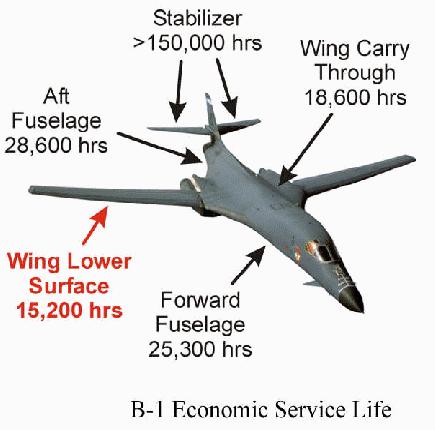 The basis for the projection of useful life of the B-1 is the Aircraft Structural Integrity Program (ASIP). The useful life of the structure is assumed to be the point at which it is more economical to replace the aircraft than to continue structural modifications and repairs necessary to perform the mission. The limiting factor for B-1’s service life is the wing lower surface. At 15,200 hours, based on continued low level usage, the wing’s lower skin will need replacement. Current usage rates, operational procedures, and mishap attrition will place the inventory below the requirement of 89 aircraft in 2018, while the service life attrition will impact around 2038.
The basis for the projection of useful life of the B-1 is the Aircraft Structural Integrity Program (ASIP). The useful life of the structure is assumed to be the point at which it is more economical to replace the aircraft than to continue structural modifications and repairs necessary to perform the mission. The limiting factor for B-1’s service life is the wing lower surface. At 15,200 hours, based on continued low level usage, the wing’s lower skin will need replacement. Current usage rates, operational procedures, and mishap attrition will place the inventory below the requirement of 89 aircraft in 2018, while the service life attrition will impact around 2038.
On 26 March 1996 it was announced that the 77th Bomb Squadron would return to Ellsworth. On 1 April 97, the squadron again activated at Ellsworth as the geographically separated 34th Bomb Squadron completed its transfer to its home at the 366th Wing, Mountain Home AFB, Idaho. By June 1998, the 77th had six of its B-1Bs out of the reconstitution reserve. This number ballanced those lost by the 34th BS.
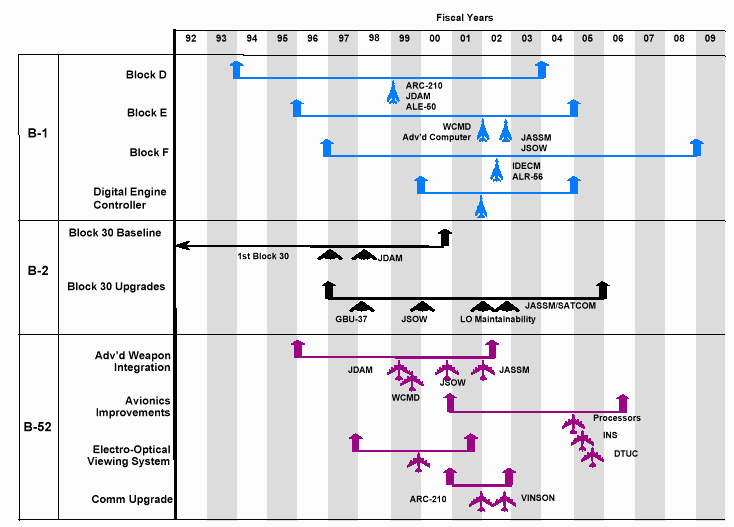
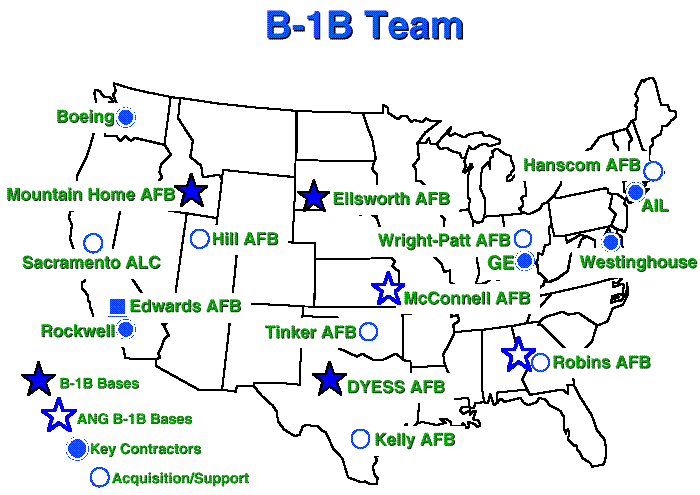
Specifications |
|||||||||||||||||||||||||||||||||||||
| Primary Function: | Long-range, multi-role, heavy bomber | ||||||||||||||||||||||||||||||||||||
| Builder: | Rockwell International, North American Aircraft | ||||||||||||||||||||||||||||||||||||
| Operations Air Frame and Integration: | Offensive avionics, Boeing Military Airplane; defensive avionics, AIL Division | ||||||||||||||||||||||||||||||||||||
| Power Plant: | Four General Electric F-101-GE-102 turbofan engine with afterburner | ||||||||||||||||||||||||||||||||||||
| Thrust: | 30,000-plus pounds (13,500-plus kilograms) with afterburner, per engine | ||||||||||||||||||||||||||||||||||||
| Length: | 146 feet (44.5 meters) | ||||||||||||||||||||||||||||||||||||
| Wingspan: | 137 feet (41.8 meters) extended forward, 79 feet (24.1 meters) swept aft | ||||||||||||||||||||||||||||||||||||
| Height: | 34 feet (10.4 meters) | ||||||||||||||||||||||||||||||||||||
| Weight: | Empty, approximately 190,000 pounds (86,183 kilograms) | ||||||||||||||||||||||||||||||||||||
| Maximum Takeoff Weight: | 477,000 pounds (214,650 kilograms) | ||||||||||||||||||||||||||||||||||||
| Speed: | 900-plus mph (Mach 1.2 at sea level) | ||||||||||||||||||||||||||||||||||||
| Rotate and Takeoff Speeds: | 210 Gross - 119 Rotate kts / 134 kts Takeoff 390 Gross - 168 kts Rotate / 183 kts Takeoff |
||||||||||||||||||||||||||||||||||||
| Landing Speeds: | 210 Gross - 145 kts 380 Gross - 195 kts |
||||||||||||||||||||||||||||||||||||
| Range: | Intercontinental, unrefueled | ||||||||||||||||||||||||||||||||||||
| Ceiling: | Over 30,000 feet (9,000 meters) | ||||||||||||||||||||||||||||||||||||
| Crew: | Four (aircraft commander, pilot, offensive systems officer and defensive systems officer) | ||||||||||||||||||||||||||||||||||||
| Armament: |
|
||||||||||||||||||||||||||||||||||||
| Date Deployed: | June 1985 | ||||||||||||||||||||||||||||||||||||
| Unit Cost: | $200-plus million per aircraft | ||||||||||||||||||||||||||||||||||||
| Inventory: |
100 total production 93 total current inventory
Active force, 51 PMAI (69 actual) Deployment
| ||||||||||||||||||||||||||||||||||||
Airframe Inventory | ||||
| # | Tail # | Name | Location | Comment |
| 1 | ||||
| 2 | 83-0065 | Star of Abilene | Dyess | |
| 3 | 83-0066 | Ole' Puss | Dyess | |
| 4 | 83-0067 | Texas Raider | Dyess | |
| 5 | 83-0068 | Predator | Dyess | |
| 6 | 83-0069 | The Beast | Dyess | |
| 7 | 83-0070 | 7 Wishes | Dyess | |
| 8 | 83-0071 | Spitfire | Dyess | |
| 9 | 84-0049 | Edwards | ||
| 10 | 84-0050 | Dawg B-One | Dyess | |
| 11 | 84-0051 | Boss Hog | Dyess | |
| 12 | 84-0052 | Lost 09-25-87 @ La Junta, Colorado | ||
| 13 | 84-0053 | Lucky 13 | Dyess | |
| 14 | 84-0054 | Rage [Tasmanian Terror] | Dyess | |
| 15 | 84-0055 | Shockwave [Lethal Weapon] | Dyess | |
| 16 | 84-0056 | Sweet Sixteen | Dyess | |
| 17 | 84-0057 | Hellion | Dyess | |
| 18 | 84-0058 | Eternal Guardian | Dyess | |
| 19 | 85-0059 | |||
| 20 | 85-0060 | McConnell | ||
| 21 | 85-0061 | Ellsworth | ||
| 22 | 85-0062 | Uncaged | Dyess | |
| 23 | 85-0063 | Lost 11-09-88 @ Dyess AFB, Texas | ||
| 24 | 85-0064 | McConnell | ||
| 25 | 85-0065 | |||
| 26 | 85-0066 | On Defense | Ellsworth | |
| 27 | 85-0067 | |||
| 28 | 85-0068 | Edwards | ||
| 29 | 85-0069 | McConnell | ||
| 30 | 85-0070 | |||
| 31 | 85-0071 | |||
| 32 | 85-0072 | Polarized | Dyess | |
| 33 | 85-0073 | McConnell | ||
| 34 | 85-0074 | Crew Dawg | Dyess | |
| 35 | 85-0075 | Ellsworth | ||
| 36 | 85-0076 | Lost 11-17-89 @ Ellsworth AFB S.D. | ||
| 37 | 85-0077 | Ellsworth | ||
| 38 | 85-0078 | Ellsworth | ||
| 39 | 85-0079 | Ellsworth | ||
| 40 | 85-0080 | |||
| 41 | 85-0081 | |||
| 42 | 85-0082 | Global Power | Dyess | |
| 43 | 85-0083 | Ellsworth | ||
| 44 | 85-0084 | Ellsworth | ||
| 45 | 85-0085 | Ellsworth | ||
| 46 | 85-0086 | Ellsworth | ||
| 47 | 85-0087 | Ellsworth | ||
| 48 | 85-0088 | |||
| 49 | 85-0089 | |||
| 50 | 85-0090 | Ellsworth | ||
| 51 | 85-0091 | Robins | ||
| 52 | 85-0092 | Ellsworth | ||
| 53 | 86-0093 | Ellsworth | ||
| 54 | 86-0094 | Ellsworth | ||
| 56 | 86-0096 | Ellsworth | ||
| 57 | 86-0097 | Robins | ||
| 58 | 86-0098 | Ellsworth | ||
| 59 | 86-0099 | Ellsworth | ||
| 60 | 86-0100 | Phoenix | Dyess | |
| 61 | 86-0101 | Heavy Metal | Dyess | |
| 62 | 86-0102 | Ellsworth | ||
| 63 | 86-0103 | Reluctant Dragon | Dyess | |
| 64 | 86-0104 | Robins | ||
| 65 | 86-0105 | Snake Eyes | Dyess | |
| 66 | 86-0106 | Lost 12-01-92 @ IR 165, Van Horne TX | ||
| 67 | 86-0107 | |||
| 68 | 86-0108 | Alein With An Attitude | Dyess | |
| 69 | 86-0109 | Spectre | Dyess | |
| 70 | 86-0110 | Stairway to Heaven | Dyess | |
| 71 | 86-0111 | Ellsworth | ||
| 72 | 86-0112 | Black Widow | Dyess | |
| 73 | 86-0113 | Ellsworth | ||
| 74 | 86-0114 | Ellsworth | ||
| 75 | 86-0115 | |||
| 76 | 86-0116 | Robins | ||
| 77 | 86-0117 | Night Stalker | Dyess | |
| 78 | 86-0118 | Robins | ||
| 79 | 86-0119 | The Punisher | Dyess | |
| 80 | 86-0120 | Iron Horse | Dyess | |
| 81 | 86-0121 | Robins | ||
| 82 | 86-0122 | |||
| 83 | 86-0123 | [none] | ||
| 84 | 86-0124 | Dyess | ||
| 85 | 86-0125 | Robins | ||
| 86 | 86-0126 | |||
| 87 | 86-0127 | |||
| 88 | 86-0128 | Ellsworth | ||
| 89 | 86-0129 | Ellsworth | ||
| 90 | 86-0130 | Bad Company | Dyess | |
| 91 | 86-0131 | Robins | ||
| 92 | 86-0132 | Oh, Hard Luck | Dyess | |
| 93 | 86-0133 | Ellsworth | ||
| 94 | 86-0134 | Robins | ||
| 95 | 86-0135 | Deadly Intentions | Dyess | |
| 96 | 86-0136 | |||
| 97 | 86-0137 | Ace In The Hole | Dyess | |
| 98 | 86-0138 | Robins | ||
| 99 | 86-0139 | Robins | ||
| 100 | 86-0140 | Last Lancer | Dyess | |
